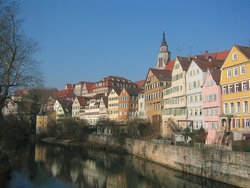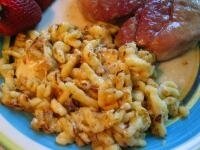Oktoberfest: Spaetzle and Zwiebelkuchen Recipes 🥁🥁🥁🥁🥁
/
Germany is the kind of country that is actually more picture perfect than the postcards you send home. Clay tile roofs top venerable stucco and timber dwellings, where cobbled squares host markets that quite literally overflow with fresh flowers, fruits, and mellow cheeses. Gothic churches and medieval castles etch into the clear skies, while tired shoppers visit in the outdoor cafes or rub shoulders with each other in the cozy pubs.

In fact, every day looks like a small festival, but for a two-week period in the fall, it is Festival with a capital F – or should I say capital O since it is to Oktoberfest that refer. The first Oktoberfest was held from October 12th - October1 7th, 1810, in Munich to celebrate the wedding of Prince Ludwig of Bavaria and Princess Therese of Sachsen-Hidburhausen, but today it runs mostly during September to take advantage of better weather.
Masses descend upon Munich’s Bierzelt (beer tents) to drink the special beer brewed for the occasion. It is “slightly darker and stronger, in both taste and alcohol” and is served in a special one-liter tankard. The six million annual visitors wash down sausage, chicken, sauerkraut and some Bavarian delicacies such as roast ox tails with the brew.
My own celebrations of Oktoberfest reflect traditions from the green rolling Swabian hills to Munich’s west, where wine replaces beer, and two Swabian favorites complement the sausage and sauerkraut. In the summer of 1983 our family was lucky enough to live in Tubingen, a medieval town nestled on the banks of the Neckar River while my husband taught at its university.

Many times we walked through the woods to a nearby castle to drink the apfelwein, not too different from apple cider, and we were always glad that we had the fresh air on the trip home to clear our heads from the potency that insinuated itself so innocently upon us. On a recent trip back we found the castle; our 20 some years older limbs were up to the trek, but sadly the apfelwein was no longer on the menu. I had to settle for some rotwein (plain old red) but it was still a great experience.

The two Swabian favorites are spaetzle, a noodle dumpling that is the ultimate comfort food, and zwiebelkuchen, a quiche-like onion pie to die for. In fact, the spaetzle is such a favorite of my husband’s that he selected the pubs he visited not on the beer selection, but on the quality of the spaetzle.
The Mayerhofle, tucked away in the labyrinth of cobbled streets, still serves his favorite, Kaese Spaetzle (Cheese Spaetzle). We toast its arrival with our dear friend Gerhard on a recent visit. True old time cooks use a special knife to pare tendrils of the dough into a boiling pot; modern enthusiasts prefer a special press to coax out the fat noodles. (You can also use a potato ricer, colander, or cheese grater.)
When it came time to name our Weimaraner, of course, we named him Spaetzle, but our dog doesn’t like people to know that his name, translated means noodle dumpling. Instead, he implies that he is named after the Spoetzle Brewery in Shiner, Texas, makers of Shiner Bock. The brew itself comes close to what you might get in Munich at the official Oktoberfest. Here’s what Mike Best has to say about it, along with some local color of his own.

A seasonal brew, Shiner Bock is a full-flavored, deep amber-colored beer. Its handcrafted brewing process [there’s only 50 employees] creates an inviting smooth taste without the excessive bitterness that characterizes many micro, specialty and imported beers. Unfortunately Shiner is only distributed to 22 states, so if you’re intent on sampling it for the first time, you may have to travel. If, when and where you find it, make sure it’s ONLY from the tap. Where that tap is makes no never mind. Any common icehouse with picnic tables, a jukebox and tin pales of beer is fine most of the time. When it comes to October and Bock, however, I prefer to go to the hole.
That’s The Hole in the Wall in Austin. Officially named The Hole in the Wall Arcade and Restaurant, this well-known establishment sits across the street from the University of Texas campus literally in the shadow of the Clock Tower from which Charles Whitman killed 14 people with his rifle in 1967. Inside its confines you can play pool, cavort with oodles of gorgeous co-eds, eat the world’s most dangerous food, Chicken Fried Steak, listen to great local music and of course, drink ice cold pitchers of Shiner Bock. Take it from me, Ol’ Son, if you’re in Texas in October, there isn’t a better place to plant your fanny.
You beer aficionados can learn more at Brian's Belly.
The zwiebelkuchen (onion pie) is usually washed down with new wine – that is wine that is green and cloudy and still fermenting. Having visited in the summer months, I have never had this delicacy, and from what I’ve read, I am not too disappointed about it. Apparently the combination of the fermenting wine and the rich onion pie wreaks havoc on the digestion, but with beer or regular wine I have had no problems. My recipe for the Zwiebelkuchen calls for pie pastry, but I’ve also seen it done well with a yeast dough. I once used a can of biscuit rolls with good results.
*[ EM-en-tahl-er ] Switzerland's oldest and most important cheese, Emmentaler has a distinctively nutty-sweet, mellow flavor that makes it perfect for almost any use-from snacks to an après-dinner fruit-and-cheese plate. This cow's-milk cheese is light gold in color, with marble-size holes and a natural light brown rind. It was named for Switzerland's Emmental valley and is exported in giant wheels weighing from 150 to 220 pounds each.
If you can, visit one of the many small towns across the U.S. that have their own version of Oktoberfest, or if you would rather avoid crowds of inebriated festivalgoers, host your own. Whip up some German potato salad or try the spaetzle or zwielbekuchen instead for a unforgettable experience. Then give the grill a final bow before it’s tucked away for the winter, and fill it with German sausage and brats. Sit back in the yard with a few of your friends, watch the smoke curl up among the falling amber leaves, and throw back a few tall cool ones. It doesn’t get any better than this.
Here are a few more German recipes you might enjoy as well as the films that go along with them:
Berlin Sole with White Chocolate and Smoked Salmon
Kaese Spaetzle
"A tasty homemade pasta tossed with onion and Emmentaler cheese. A German version of macaroni and cheese." Original recipe yield: 8 servings.
Ingredients
1 1/2 cups all-purpose flour
3/4 teaspoon ground nutmeg
3/4 teaspoon salt
1/8 teaspoon pepper
3 eggs
3/8 cup 2% milk
3 tablespoons butter
1 onion, sliced
1 1/2 cups shredded Emmentaler cheese (Or substitute Swiss or Cheddar)
Directions
Sift together flour, nutmeg, salt and pepper. Beat eggs in a medium bowl. Alternately mix in milk and the flour mixture until smooth. Let stand for 30 minutes.
Bring a large pot of lightly salted water to a boil. Press batter through a spaetzle press into the water. You may also use a potato ricer, colander, or a cheese grater. When the spaetzle has floated to the top of the water,
remove it to a bowl with a slotted spoon. Mix in 1 cup of the cheese.
3 Melt butter in a large skillet over medium-high heat. Add onion, and cook until golden. Stir in spaetzle and remaining cheese until well blended. Remove from heat, and serve immediately.
German Zwiebelkuchen (Onion Pie)
"Zwiebelkuchen is an onion pie from Swabia, in south-central Germany. It is a special time of year, in the fall, when the mom & pop winemakers will open a BasinWirtschaft in their barn or garage. They serve the new wine, fresh zwiebelkuchen, and perhaps some wurst, for a minimal fee. A few tables are set up, and they are open when they have time to serve. To indicate they are serving, they will hang a straw broom over the doorway. The combination of the onions and the 'green' wine can have explosive consequences later on!" Original recipe yield: 10 to 12 servings.
Ingredients
6 pounds onions, sliced
4 slices bacon
1 (16 ounce) container sour cream
4 eggs
2 tablespoons all-purpose flour
1/2 teaspoon salt
1/2 teaspoon caraway seed
2 recipes pastry for a 9 inch single crust pie
Directions
Preheat oven to 425 degrees F (220 degrees C). Line a jelly-roll pan or large pizza pan with prepared dough, making sure dough extends up sides of pan.
Saute onion until translucent and pour cooked onion into a large mixing bowl. Place bacon in a large, deep skillet. Cook over medium high heat until evenly brown. Drain, chop and add to onion; mix well.
Stir in sour cream. Beat eggs enough to break up yolks, then mix in to pie mixture. Add flour to thicken mixture (onions will create a lot of water), then add salt. Mix well and pour mixture into prepared pan. Sprinkle top with caraway seed.
Bake in preheated oven for about 1 hour, or until onions start to turn golden brown on top.
http://maindish.allrecipes.com/az/GrmnZwiblkchnninPi.asp
Bill Whitford












